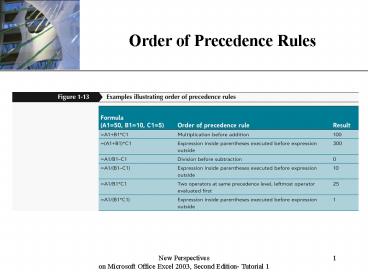New Perspectives on Microsoft Office Excel 2003, Second Edition- Tutorial 1 - PowerPoint PPT Presentation
1 / 15
Title:
New Perspectives on Microsoft Office Excel 2003, Second Edition- Tutorial 1
Description:
Title: PowerPoint Presentation Author: Course Technology Last modified by: smc Created Date: 8/29/2001 9:35:42 PM Document presentation format: On-screen Show (4:3) – PowerPoint PPT presentation
Number of Views:166
Avg rating:3.0/5.0
Title: New Perspectives on Microsoft Office Excel 2003, Second Edition- Tutorial 1
1
Order of Precedence Rules
2
Resize worksheet rows and columns
- There are a number of methods for altering row
height and column width using the mouse or menus
- Click the dividing line on the column or row, and
drag the dividing line to change the width of the
column or height of the row - Double-click the border of a column heading, and
the column will increase in width to match the
length of the longest entry in the column - Widths are expressed either in terms of the
number of characters or the number of screen
pixels.
3
Resize a column
4
Identify cell ranges
- A group of worksheet cells is known as a cell
range, or range. - Working with ranges in a worksheet makes working
with the data easier. - Ranges can be adjacent or nonadjacent.
- An adjacent range is a single, rectangular block
of cells - Select an adjacent range by clicking on a cell
and dragging to an opposite corner of a rectangle
of cells - A nonadjacent range is comprised of two or more
adjacent ranges that are not contiguous to each
other - To select a nonadjacent range, begin by selecting
an adjacent range, then press and hold down the
Ctrl key as you select other adjacent ranges
5
Select and move worksheet cells
- To select a large area of cells, select the first
cell in the range, press and hold the Shift key,
and then click the last cell in the range. - Once you have selected a range of cells, you may
move the cells within the worksheet by clicking
and dragging the selection from its current
location to its new one. - By pressing and holding the Ctrl key as you drag,
Excel will leave the original selection in its
place and paste a copy of the selection in the
new location. - To move between workbooks, use the Alt key while
dragging the selection.
6
Adjacent and nonadjacent ranges
7
Range selection techniques
8
Moving selected cell ranges
9
Insert worksheet rows and columns
- You can insert one or many additional rows or
columns within a worksheet with just a few steps
using the mouse or menu options. - You can insert individual cells within a row or
column and then choose how to displace the
existing cells. - You can click the Insert menu and then select row
or column, or right click on a row or column
heading or a selection of cells and then choose
Insert from the shortcut menu.
10
Delete worksheet rows and columns
- To delete and clear cells, rows, or columns, you
can use the Edit menu, or right click on a
heading or a selection of cells and choose Delete
from the shortcut menu. - Clearing, as opposed to deleting, does not alter
the structure of the worksheet or shift uncleared
data cells. - What can be confusing about this process is that
you can use the Delete key to clear cells, but it
does not remove them from the worksheet as you
might expect.
11
The Insert dialog box
12
Use the Undo and Redo features
- Editing is an intrinsic task in any document, and
especially useful are the Undo and Redo actions. - The Undo feature allows you to sequentially back
up to a certain action, such as a delete, a move,
an entry, etc. and allows you to reverse those
actions. - Redo allows you to reapply actions one step at a
time that you have previously undone.
13
Insert, move, and rename worksheets
- Worksheets are much like pages within a book you
peruse through them like you flip the pages of a
book. - There are several ways to move, copy and work
with worksheets. - Right click on the sheet tab and choose Move or
Copy. Select a new position in the workbook for
the worksheet or click the Create a copy checkbox
and Excel will paste a copy of that worksheet in
the workbook. - The same shortcut menu for the sheet tab also
gives you the option to insert, delete or rename
a worksheet.
14
Print a workbook
- To Print a worksheet, you can use
- A menu
- The Print button on the standard toolbar
- The Ctrl-P keystroke to initiate a printout of
the worksheet - Excel uses the same basic methods for printing as
other Windows and Microsoft Office applications.
15
The Print dialog box































